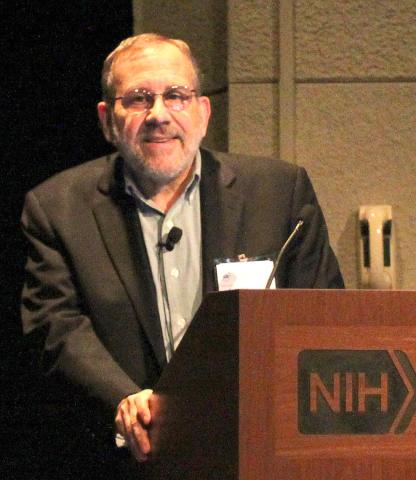‘Audacious Goals’
Sanes Kicks Off Seminar Series in Neuroregeneration

Like a computer, the central nervous system employs vast circuits to collect and process information, enabling us to walk, talk, think and see. But instead of silicon chips to relay signals, our circuits are built from long, wiry cells called neurons. Dr. Joshua Sanes recently visited NIH to talk about his research aimed at understanding how neurons connect to form these circuits. His talk was the first in the new NEI Audacious Goals Initiative (AGI) Seminar Series in Neuroregeneration.
Sanes is director of the Center for Brain Science and professor of molecular and cellular biology at Harvard University. He is also a member of the NEI AGI steering committee. The AGI is an NEI-led effort to catalyze vision research by leveraging recent major scientific advances. Central to the AGI is the audacious goal of restoring sight through regeneration of neurons of the retina—the light-responsive tissue in the back of the eye—and their connections to the brain.
Although Sanes has been a neurobiologist for many years, his attention to the retina is relatively new. Why the retina? The retina is the best available model for studying neuronal circuits, he said. Scientists can use light to control input to retinal circuits. And output from the circuits can be recorded easily because all retinal neurons converge at the optic nerve before extending to other parts of the brain. And, Sanes said, the retina is the only part of the central nervous system that is accessible without surgery. It even comes with its own lens, he said.
Sanes outlined his lab’s characterization of a retinal circuit that detects direction of motion, for example, a ball moving across a scene. To understand the formation of these complex circuits, composed of multiple cell types, it’s critical to identify factors that help guide their wiring pattern. Using various techniques, including genetically modified mice, Sanes and colleagues found that specific signaling molecules called cadherins dictate configurations of neurons. Like color-coded wires, the cadherins guide neurons to their appropriate junctions.
Motion-detecting circuits are dedicated to this one job. There are more than 100 different types of neurons in the retina that intermingle to form distinct circuits with other dedicated functions. The result is what Sanes described as a series of 30 or more parallel images, each detecting a different feature, such as color, size and texture. “The retina then sends this information to the brain, which has the job of reconstructing these images to give you the illusion that you’ve seen the world as it is,” he said.
Sanes summarized recent technological advances that he and other scientists are using to study neuronal circuits. He is particularly enthusiastic about a technique called drop-seq, which allows measurement of RNA in single cells. Since RNA is made by the genes that are active in unique cell types, a cell’s pattern of RNA expression provides a way to identify it. Like reading a barcode, drop-seq allows scientists to quickly scan and classify cells. Many cells that are currently classified together based on appearance might be re-classified based on their RNA expression patterns and functions.
Sanes’ work holds relevance for the development of neuroregenerative therapies, especially therapies for retinal diseases. Loss of retinal neurons is responsible for the majority of blindness in the U.S. There are hundreds of rare diseases that can cause degeneration of retinal neurons. Common ones include glaucoma, age-related macular degeneration and diabetic retinopathy.
“AGI aims to regenerate neurons to make a difference in human vision,” NEI director Dr. Paul Sieving explained during introductory remarks. Whereas humans cannot regenerate retinal neurons, other animals can, he said, citing goldfish as an example. AGI is about recapitulating this process as a therapy for humans.
Visit https://nei.nih.gov/audacious/ to view Sanes’ talk and learn about upcoming seminars.
